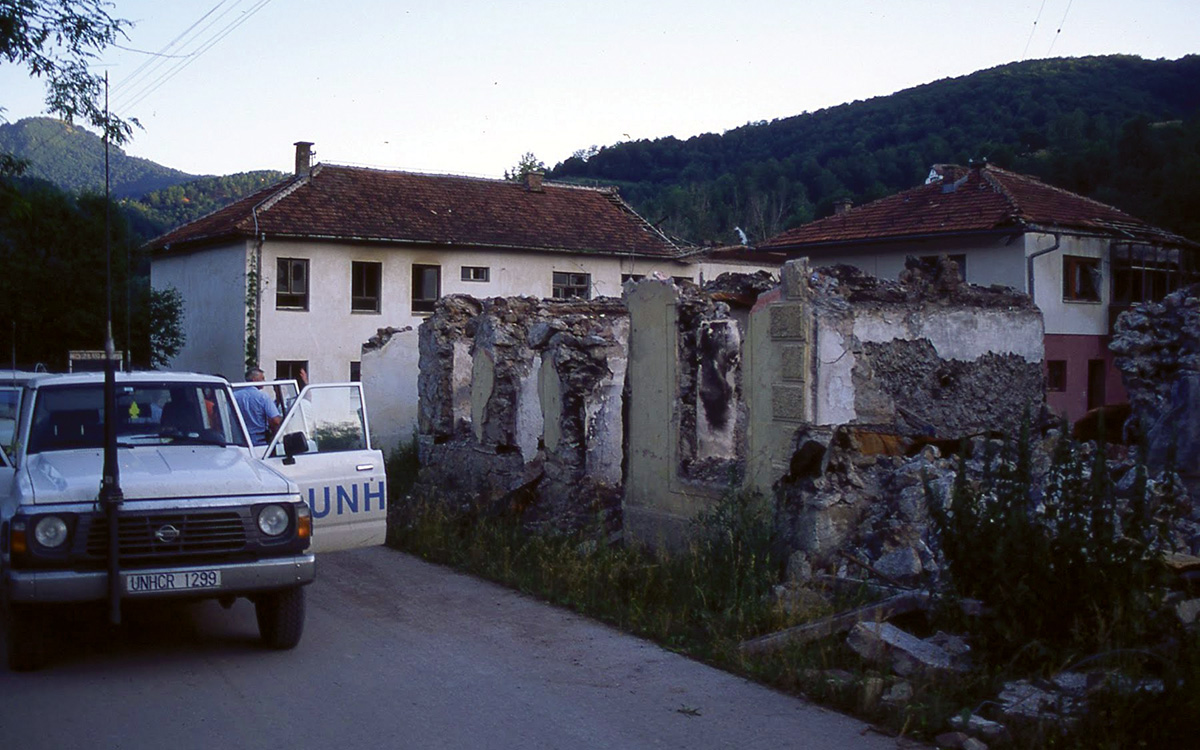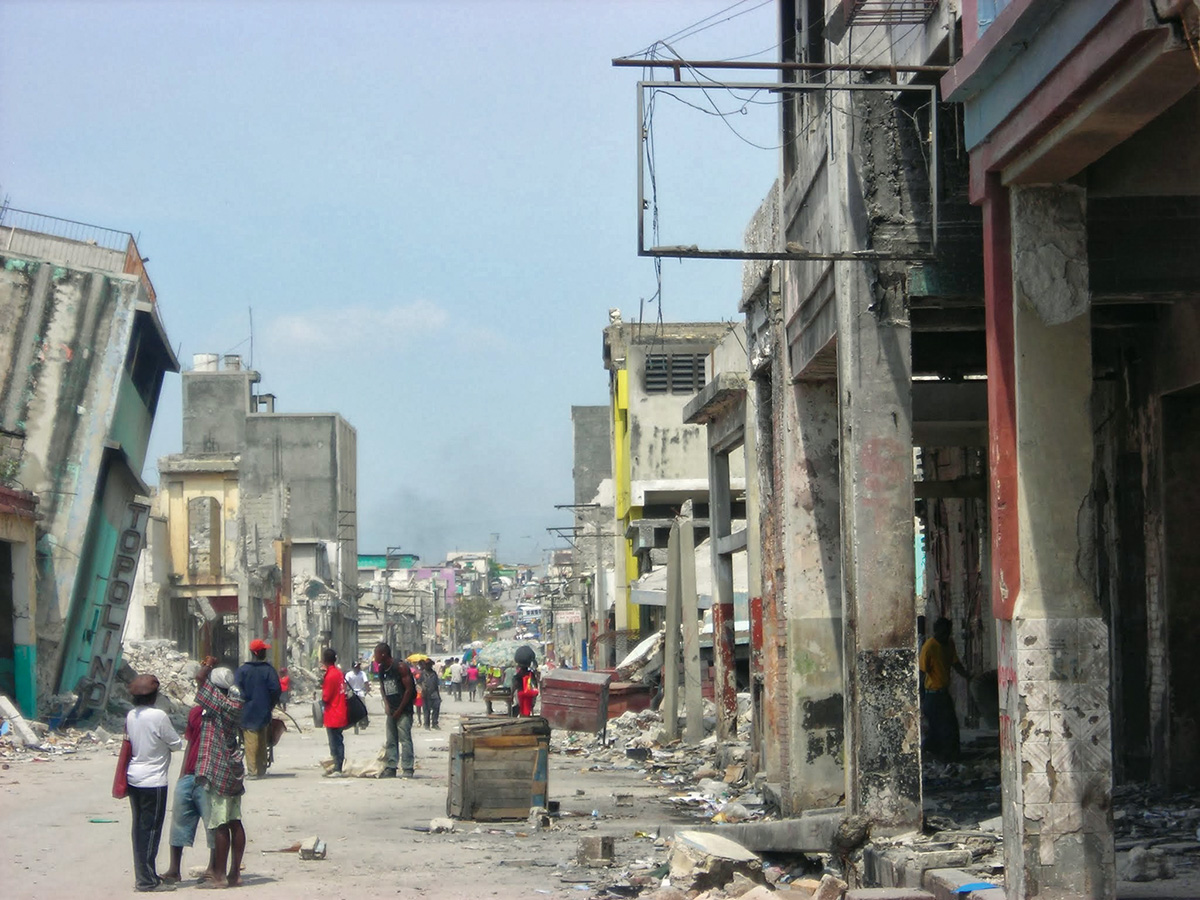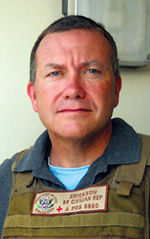Migration Seizes the Spotlight
Migration is testing national policy in many countries. The questions it raises go to the heart of the international order.
BY ANDREW ERICKSON

The Bosnia crisis demonstrated that mass refugee outflows on the fringes could have significant domestic political consequences in Europe. Here a UNHCR crew assesses refugee return prospects in a ruined Balkan village in 1996.
Courtesy of Andrew Erickson
Tied to labor requirements in more advanced countries or asylum claims from refugees, migration has traditionally been an experts’ issue, discreetly handled. This is changing rapidly. In 2016 migration exploded internationally as a major domestic political issue in many countries.
In the United States, how we deal with visitors, migrants and asylum-seekers is a political hot potato that repeatedly ends up in the courts. On our southern border, questions about who gets asylum and why play out against the backdrop of policy decisions on the fate of beneficiaries of the DREAM Act and unaccompanied minors. While Mexico grapples with addressing transit migration toward the United States, South America struggles with fleeing Venezuelans. In Africa refugee numbers soar as countries struggle to sustain millions fleeing conflict and crisis. Australia’s approach to asylum-seekers is a major political issue there.
Conflicts and poverty in the Middle East boost migration. Turkey hosts nearly four million refugees and also generates economic migrants. Europe also hosts millions. In 2016, motivated in part by concerns over immigration, Britons voted to leave the European Union. The rise of far-right parties across Europe is also tied to the impact of immigration. An American president with strong views on migration was elected. Recent elections in Germany, Italy and Sweden further underscore the deep unease with which elements of our electorates view immigration.
Today the United Nations High Commissioner for Refugees counts about 68.5 million forcibly displaced people worldwide, including 40 million internally displaced, 25.4 million refugees (among them 5.4 million Palestinians) and 3.1 million asylum-seekers.
When I was stationed in Geneva as a migration officer at the beginning of the 21st century, the discussion was largely focused on the need for more refugee slots in the developed world. Today a less one-sided dialogue is required. A comprehensive diplomatic approach should include revisiting the 1951 Refugee Convention to recast the rights and responsibilities therein. This will require State Department leadership if the basic principles of asylum are to be safeguarded.
Popular Attitudes, Demographic Decline and Policy Challenge
Popular concern about migration is soaring, while formerly welcoming rich countries’ doors are closing. After German Chancellor Angela Merkel welcomed large numbers of Middle Eastern refugees to Germany in August 2015, voter angst rocked Europe. In the face of historically unprecedented levels of immigration, Europe is testing the frontiers of multiculturalism. According to the Organization for Economic Cooperation and Development, in 2017 the share of foreign-born residents of Sweden was 18 percent; in Ireland, 17.1 percent; in Austria, 19 percent; in Spain, 13 percent; in the U.K., 14 percent; and in Germany, 15 percent. Sweden may have a non-ethnically Swedish-majority population by the end of the century.
As migrant populations grow, demographic decline among the native-born hollows out large European states. Spain has one of the lowest fertility rates in the world. Germany’s present population is 87 million; by 2060, it could fall by 15 million. In 2014 fewer babies were born in Italy than in any year since 1861.
The situation in the United States is no better. According to the Centers for Disease Control and Prevention, the current U.S. birthrate of 1,766 per 10,000 is 16 percent below what is needed for population stability. We must accept a shrinking population or welcome more immigrants. America also faces skill shortages and needs specific scientific, technical, engineering and mathematics (STEM) talents. Future innovators will and do come from all over the world. Today foreign-born residents constitute almost 14 percent of our population—the highest percentage since 1910. More of them will need to be skilled.
In the face of historically unprecedented levels of immigration, Europe is testing the frontiers of multiculturalism.
Elite or specific skills migration can be managed with points systems, special visa categories and other measures addressing critical labor shortfalls. What about unskilled workers? Is the pressing need for certain migrants an argument for more USAID programs to improve education in the developing world? How do we square skills-based migration with our country’s tradition of mass immigration? Are visa lotteries the best way to identify immigrants?
Labor mobility is key to economic growth. As fertility rates in rich nations decline, migration will meet labor demand. With retirement systems facing unsustainable numbers of pensioners, governments can manage immigration to ensure systemic viability. Countries needing workers already welcome migrants. Just as political refugees leave oppression for freedom, so economic migrants can do the same in search of better lives. Rich and poor lands should equally benefit.
We are a land of immigrants. Yet in 2018 Americans told Gallup pollsters that the number-one problem America faces is immigration. Our president speaks of undocumented migrants and asylum-seekers as a national security threat. Elsewhere, French voters’ long flirtation with the far right is grounded in unhappiness with immigration. It’s simplistic to deride voter disquiet as racism; in a democracy, citizens have a voice. Whatever people in Sweden decide about how immigration affects their future as a nation, they have a right to their national conversation.
While legitimate refugees have no option but flight and a quest for asylum, other migrants have no option but to try to work the system. Seeking asylum in Europe or remaining without permission in the United States are now the only alternatives for most non-elite would-be immigrants—whether they’re refugees or not. The situation is unsustainable.
A Comprehensive Response Is Needed
Migration is about people and numbers. In 2004 the United Nations projected that Africa’s population would level off by 2100, at around two billion. Today the U.N. projects Africa’s population will reach 4.5 billion by century’s end. With the pull of our economies combined with the push of migrant desperation, there is no sea wide enough nor wall high enough to deter would-be immigrants. Latin America and South Asia are also experiencing dramatic population growth.
Today’s migration picture is one of musical chairs. Poor, dysfunctional and conflictive countries generate far more emigrants than rich countries can welcome as immigrants. Supply and demand are misaligned; emigrants who can’t become immigrants have nowhere to go. Those who do succeed at immigration will be of different ethnicities, religions and cultures from their new homelands. British academics Roger Eatwell and Matthew Goodwin speak of “hyper ethnic change” to describe what is occurring. In National Populism: The Revolt Against Liberal Democracy (Pelican, 2018), they note: “Public worries over immigration and ethnic change, and the concomitant intellectual debates, look set to intensify rather than fade. This is because hyper ethnic change will not only continue but accelerate.”
The arrival of hundreds of thousands on our southern border and the plight of millions of asylum-seekers around the world require informed and coherent policymaking. If nothing else, the changing religious, cultural and ethnic mix of our nation invites reflection. How much dysfunction and injustice in migrant-producing countries can be assuaged by emigrant flight? How do we reduce migrant flows while assuring the skilled immigrants we require? How generously should we assess asylum claims—and on what grounds? How do we ensure our migration policies are not racist, even as voters express increasing concern about immigrant multiculturalism?
Migration today poses unprecedented transnational challenges. With so many people on the move, no responsible policymaker can deny that the 1951 Convention and its 1967 Protocol governing asylum-seekers might require revision. How do we continue to offer asylum to the most critical cases—and what are those cases? How do we distinguish between an asylum-seeker’s flight from a dysfunctional homeland and a “well-founded fear of persecution?” The convention lays considerable responsibility to host refugees upon signatories, and it notably exempts refugees from reciprocity. (Granting a right to a refugee should not be subject to the granting of similar treatment by the refugee’s country of nationality, because refugees do not enjoy the protection of their home state.)
What happens when voters endorse politicians rejecting national commitments to refugees under international law? How do we protect migrants fleeing genocide or simple oppression? Restrictive migration policies in place during the 1930s meant that even more people died in the Holocaust. Providing asylum is a moral responsibility. Developing countries in Africa, in particular, already host vast refugee populations. Is it fair for rich countries to close their doors, leaving refugees in countries already struggling with widespread poverty? These are core questions of the international order.
Varying Attitudes on Immigrants and Integration

Many Haitians fled their country after the 2010 earthquake left the country in ruins. How does a just migration policy treat people such as these?
Courtesy of Andrew Erickson
While Europe has faced vast population shifts in its history, particularly after World War II, for the most part these involved ethnic co-nationals lining up with postwar border changes. Europe’s new generation of immigrants is different. Muslim immigrants to Europe face obstacles to integration that previous migrants did not. Yet Muslim-majority lands are the most likely source of much immigration to Europe.
Countries manage integration differently. The United States tends to be laissez-faire in assimilating migrants, counting on economic and social pressure for integration. Turning newcomers into citizens has long been one of our greatest strengths. I spent 2018 with a varied group of refugees in an integration course in Germany and can attest that some recent migrants, many from historically non-Christian countries, speak of “integration without assimilation.” They argue that beyond having access to economic and educational opportunities, they should be left alone to live as they please. Their argument is strong on religious liberty grounds, but it raises the risk of divided societies. Are there limits to immigrant multiculturalism, as some argue?
Most European countries define their identities culturally. Danes, for instance, see their society as a social contract with a very specific set of “Danish” rules and values developed over history. Fearing division, Denmark has set controversial new measures to compel, specifically, Muslim migrant assimilation. Copenhagen requires immigrant children in designated communities to attend Danish early childhood education. In 2018 Denmark also banned the burqa and the niqab, two garments associated with conservative Islam. How should we address issues like this in our human rights reports?
Policymaking would be easier if one could chart a linear connection between higher immigration and voting patterns. But immigration numbers alone don’t explain voter attitudes. Pew Research Center studies indicate that the relative size of immigrant communities does not always correlate with anti-immigration attitudes; it’s the political lens through which immigration is viewed that defines whether it is seen as a threat. Says Pew: “A third or more in each [European] country surveyed say immigrants increase the risk of terrorism … with Germans and Italians the most likely to express this view. Within each country, left-right ideology tends to influence these opinions more than populist views do. People on the right are at least 20 percentage points more likely than those on the left to say immigrants increase the risk of terrorism in their country.”
More Front Office Attention Is Required
Visa adjudication is migration’s human face. Anyone who has worked a visa line knows about compelling ties, reciprocity, asylum-seeking and family unification. Migration policy, however, is the multilateral big picture. In Washington, we work an interagency process grounded in national interest and domestic politics but constrained by treaties and historical practice. Critical multilateral discussions on migration policy in Geneva all too often pass under the State Department’s seventh-floor radar. This needs to change. Given the importance of migration to America, the Bureau of Population, Refugees and Migration needs more positive attention from the Secretary of State.
Foreign Service personnel need more migration policy training from A-100 through the Senior Executive Threshold Seminar. In 27 years as an FSO, I found migration policy training grossly inadequate. Migration should not remain just an expert’s issue for a functional bureau, although that functional bureau’s expertise is critical. That said, every FSO should recognize migration’s centrality to what we diplomats do. Missions should elevate migration issues in reporting plans. We need to get more aggressive at promoting refugee resettlement in nontraditional destination countries. Programs should assist regional refugee integration.
We need robust dialogue in Geneva on all elements of migration and refugee policy. Nothing should be off the table as long as we remain committed to the principle that legitimate asylum-seekers fleeing state persecution shall not be turned away. This is a difficult challenge. As diplomats, we can keep the discussion disciplined by identifying and promoting responsible dissemination of best practices, while remaining sharply observant about systemic problems. This is a policy issue best informed by good data. Information matters.
As ever more people move from one place to another, it behooves us to monitor, manage and ameliorate the conditions of planetary migration.
The 1951 Convention Relating to the Status of Refugees
Born in the shadow of the Holocaust, the 1951 Convention Relating to the Status of Refugees was a quintessential Cold War treaty. Conceived when successful flight from totalitarian regimes was rare and refugees were often intellectuals who were easily integrated in the rich West, the refugee convention was part of a patchwork of efforts to universalize Western human rights standards. The 1967 Optional Protocol amended the 1951 Convention, giving it universal coverage. The convention has since been supplemented by refugee and subsidiary protection regimes in several regions, as well as by the progressive development of international human rights law.
To the extent that today’s refugee numbers reflect the universalization of human rights worldwide, the exploding numbers of asylum-seekers represent policy success. As people everywhere internalize the idea of inalienable rights, the failure of their own societies to protect these rights is no longer simply an individual’s destiny. It’s a reason to seek asylum elsewhere.
This is where the United Nations High Commissioner for Refugees comes into the picture. Based in Geneva, Switzerland, where it coordinates with member-states, UNHCR employs more than 16,000 humanitarian workers worldwide and is the guardian of the refugee convention.
The convention defines a refugee as a “person who is outside his or her country of nationality or habitual residence; has a well-founded fear of being persecuted because of his or her race, religion, nationality, membership of a particular social group or political opinion; and is unable or unwilling to avail him- or herself of the protection of that country, or to return there, for fear of persecution.”
As our understanding of human rights has evolved over the last 70 years, the treaty has evolved, as well. In recent decades a broad expansion of human rights norms has put significant pressure on UNHCR. Not only are more people interested in asserting their human rights, but the list of rights for which protection or asylum status is potentially available has grown (including, for example, gender equality and sexual orientation, among other things).
The central challenge for migration policy practitioners fighting to protect asylum as a core attainment of the development of international human rights law is maintaining the viability of the system in the face of the relentless growth of refugee numbers worldwide, without compromising protection for the vulnerable.
—Andrew Erickson





